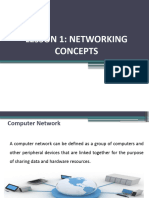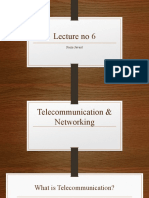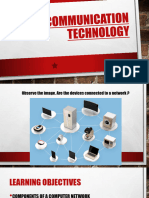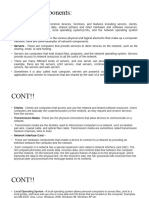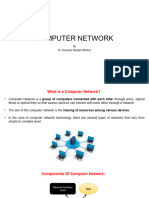0 ratings0% found this document useful (0 votes)
3 viewsInformation-Technology-Network
Information-Technology-Network
Uploaded by
kshb29msyqCopyright:
© All Rights Reserved
Available Formats
Download as PDF, TXT or read online from Scribd
Information-Technology-Network
Information-Technology-Network
Uploaded by
kshb29msyq0 ratings0% found this document useful (0 votes)
3 views23 pagesCopyright
© © All Rights Reserved
Available Formats
PDF, TXT or read online from Scribd
Share this document
Did you find this document useful?
Is this content inappropriate?
Copyright:
© All Rights Reserved
Available Formats
Download as PDF, TXT or read online from Scribd
Download as pdf or txt
0 ratings0% found this document useful (0 votes)
3 views23 pagesInformation-Technology-Network
Information-Technology-Network
Uploaded by
kshb29msyqCopyright:
© All Rights Reserved
Available Formats
Download as PDF, TXT or read online from Scribd
Download as pdf or txt
You are on page 1of 23
Information Technology
Networks & Communication Systems
Dr. GUVEN
Aerospace Engineer (P.hD)
Nuclear Science and Technology Engineer (M.Sc)
What is a Network?
• As the demands on IT systems
and computers have grown,
the need to share resources to
create an overall working
system has emerged.
• Network is the concept of
having more then one
computer, hardware devices,
software and communication
devices working in tandem
with each other for a common
purpose.
Network Materials
• Network consists of the following materials:
- Computers (Desktop, Server, Mainframe)
- Printers and other devices connected for
common use
- Communications Media for connecting these
devices (Hubs, Switches, Routers, Modems)
- Software for allowing for the system to work
together
- Protocols for determining how the data is
transmitted and how the applications are
priotorized and how the rights are determined
Types of Computer Networks
• There are mainly two types of computer
network types for computer systems
- Local Area Network
- Wide Area Network
Local Area Network (LAN)
• Local Area Network connects two or more
communicating devices within a building or
within nearby buildings.
• Every user on LAN has the potential to
communicate with every other device
• LAN allows large number of corporate users to
share resources such as printers, programs,
storage devices and data files
• LAN users can have a common access to
corporate information which can allow for
productivity
LAN
How to Connect LAN Devices?
• LAN consists of cabling or wireless technology
linking individual devices, network interface cards
(adapters that allow for network cables to be
interfaced with computers) and software to control
LAN activities
• Hub / Switch connects more then one device in a
nearby area.
• Bridge connects two networks of the same type
• Router connects LAN to Wide Area Network.
Wireless Local Area Network (WLAN)
• WLAN technologies provide LAN connectivity,
typically limited to less then 150 meters,
usually within one building.
• Wi-fi is the usage of radio technology to create
internet and network connectivity wirelessly
• Bluetooth is used for shorter range
applications to connect computers, printers
and palm pilots.
WLAN
Wide Area Networks (WAN)
• Wide area networks are long haul, broadband
networks covering wide geographic areas.
• Some WANs are commercial, while others are
private created by large corporations
• An example of a widespread public WAN is the
Internet.
• WANs may connect using cables as well as
wireless technology.
WAN
Virtual Private Network (VPN)
• Virtual Private Network is a gateway between
a corporate LAN and an Internet.
• VPN allows an access to corporate networks
email, shared files etc. with an Internet
connection
• VPN transmissions are encrypted allowing for
the necessary security for companies.
• VPNs are used as extranets
VPN
Network Transmission
• In order to create a network, you need a
medium to transmit the signal from one
computer or device to another.
• The types of transmission technology are:
1) Cable Media
2) Broadcast Media
Cable Media
• Cable Media use physical wires or cables to
transmit data and information. The three
types of cable that are available are:
• Coaxial Cable
• Twisted Pair
• Fiber optic cables
Coaxial Cable
• Coaxial Cable: These cables are like black TV
cables and they can transmit huge amounts of
information (like audio – visual signals), but
they are expensive
Twisted Pair Cable
• Twisted Pair: These cables are very
widespread and majority of networks are used
with these since they use RJ-45 connectors.
• These connectors are similar to telephone
connectors and they make connection very
easy
• Twisted pair cables consist of 8 cables twisted
around each other.
Fiber Optic Cables
• Fiber optic cables: They transmit laser signals
through glass fibers.
• They are very expensive due to high cabling costs
• A single glass fiber can carry more then 50,000
simultaneous telephone cables compared to only
5,500 calls.
• Fiber cable can carry 25 terabits of data per second.
Network Broadcast Media
• Microwave Signals
• Radio Signals
• Cellular Transmission
• Infrared
• Satellite
Broadcast Media Properties
• On the available broadcast media, satellites
have a high bandwidth and large coverage
area, but they are the most expensive. Mostly
preferred for ATM’s and similar remote
outposts.
• Radio transmissions are cheap and signals can
pass through walls. However, the security is an
issue, but all computers and notebooks use
radio technology for wireless networking.
• Microwave, infrared are susceptible to
interference
Network Management Software
• Network Operating system is a software that
controls the hardware devices, software and
communications media across the network.
• Some common network operating systems
are:
- Microsoft NT / Microsoft Server 2003-2008
- Novell Netware
Network Protocols
• The set of rules and procedures that govern
transmission across a network is called protocol.
• The principal functions of protocols in a network
are line access and collision avoidance.
• Line access is the regulation of how the sending
device gains access to the network
• Collision avoidance refers to managing message
transmission so that two messages do not collide
over the network
TCP / IP
• Transmission Control Protocol / Internet
Protocol (TCP / IP) refers to a transfer protocol
that cab send files of information across
networks with the assurance that the data will
arrive in an un corrupted form.
You might also like
- Virtualization Interview QuestionsDocument19 pagesVirtualization Interview QuestionsL94scribdNo ratings yet
- LESSON 1-Networking ConceptsDocument50 pagesLESSON 1-Networking ConceptsKirtiNo ratings yet
- IS ch04Document47 pagesIS ch04Arebu MarufNo ratings yet
- Lesson 7 Introduction To NetworksDocument20 pagesLesson 7 Introduction To NetworksEdwinNo ratings yet
- Chapter 01 Computer Networks and The InternetDocument90 pagesChapter 01 Computer Networks and The Internetgaucon12007No ratings yet
- Evolution of Computer NetworkingDocument180 pagesEvolution of Computer NetworkingypujithNo ratings yet
- CCN Part 1Document55 pagesCCN Part 1116TanzeelNo ratings yet
- Introduction To Data Communication & NetworkingDocument50 pagesIntroduction To Data Communication & NetworkingPharoahNo ratings yet
- NetworksDocument63 pagesNetworksathmajan3612No ratings yet
- Assignment: Connectivity Wireless RevolutionDocument4 pagesAssignment: Connectivity Wireless RevolutionT BabëNo ratings yet
- CSC134 Chapter 8 PDFDocument44 pagesCSC134 Chapter 8 PDFQurratul FatihahNo ratings yet
- Lecture No 6 - Telecommunication & NetworkingDocument24 pagesLecture No 6 - Telecommunication & NetworkingBASEERAT RAFIQNo ratings yet
- Module 1 - Networking Principles and Layered ArchitectureDocument121 pagesModule 1 - Networking Principles and Layered ArchitectureAkshitaSainiNo ratings yet
- Computer NetworksDocument13 pagesComputer Networkspisatsrushti27No ratings yet
- Chapter 8 - Communications and NetworksDocument44 pagesChapter 8 - Communications and NetworksAifa YasminNo ratings yet
- IntroDocument53 pagesIntroPharoahNo ratings yet
- CH 6 - Communication TechnologyDocument55 pagesCH 6 - Communication Technologyabwa.rishika.tiwari2023No ratings yet
- Basic Networking: Introduction To Computing Unit 5Document25 pagesBasic Networking: Introduction To Computing Unit 5AbdulRehman AamirNo ratings yet
- GCC Unit 1Document83 pagesGCC Unit 1Bhargava TipirisettyNo ratings yet
- CHAPTER 1 - EXPLORE THE NETWORK - ExtDocument58 pagesCHAPTER 1 - EXPLORE THE NETWORK - ExtAzizah Md AzizNo ratings yet
- Digital Fluency Unit 2 NotesDocument37 pagesDigital Fluency Unit 2 NotestejurathodnaikNo ratings yet
- 3: Network & CommunicationDocument18 pages3: Network & CommunicationMuhammad Arif Aiman bin MazlanNo ratings yet
- 02 Introduction To Computer Networking TechnologyDocument25 pages02 Introduction To Computer Networking TechnologyEthiopian CodeNo ratings yet
- Full Unit 1 Cse 306Document128 pagesFull Unit 1 Cse 306bhaveshtanwar693No ratings yet
- Unit 2: Telecommunication and Networks: Telecommunications MediaDocument45 pagesUnit 2: Telecommunication and Networks: Telecommunications MediaDivyam DiviNo ratings yet
- Computer Networks Unit12Document455 pagesComputer Networks Unit12Siddamsetti RevanthNo ratings yet
- EContent 11 2023 03 01 18 07 37 Unit1IntroductionofComputerNetworkpptx 2023 01 10 23 09 46Document113 pagesEContent 11 2023 03 01 18 07 37 Unit1IntroductionofComputerNetworkpptx 2023 01 10 23 09 46bsettle1003No ratings yet
- Computer Network Class XIIDocument49 pagesComputer Network Class XIIayush5072007No ratings yet
- Unit1 Slides-FinalDocument158 pagesUnit1 Slides-FinaldolamanijaganNo ratings yet
- 3 NetworksDocument159 pages3 NetworksSatya Ranjan MohapatraNo ratings yet
- Module 1Document12 pagesModule 1zuuo658No ratings yet
- Computer NetworkDocument409 pagesComputer NetworkKarina Rathore100% (5)
- ICT CH-4 NotesDocument9 pagesICT CH-4 Notesanish kanthethiNo ratings yet
- Chapter 1-Introduction To NetworkingDocument60 pagesChapter 1-Introduction To NetworkingMuhamad AriefNo ratings yet
- WIT Unit2 (1st Part)Document12 pagesWIT Unit2 (1st Part)Piet RajNo ratings yet
- Unit-5 - Computer Networks-Part 1Document12 pagesUnit-5 - Computer Networks-Part 1Vedant AmonkarNo ratings yet
- NetworksDocument31 pagesNetworksKritikaNo ratings yet
- Introduction To CNDocument100 pagesIntroduction To CNDr. Hitesh MohapatraNo ratings yet
- Computer Note 2Document14 pagesComputer Note 2wisedudeNo ratings yet
- Introduction, Networks Types, TopologyDocument50 pagesIntroduction, Networks Types, TopologyShahriar Haque50% (2)
- Introduction To CN-2Document88 pagesIntroduction To CN-2Jkiu MeluiNo ratings yet
- Advanced Computer NetworksDocument63 pagesAdvanced Computer NetworksArslan AkbarNo ratings yet
- Computer Network Unit 1Document69 pagesComputer Network Unit 1MalathiNo ratings yet
- 18Css202J - Computer Communications: Semester 4 - Academic Year 2021-2022 (Even)Document235 pages18Css202J - Computer Communications: Semester 4 - Academic Year 2021-2022 (Even)Alankriti KalsiNo ratings yet
- Computer Networks PPTDocument35 pagesComputer Networks PPTPawan AgnihotriNo ratings yet
- Network Types & ArchitectureDocument51 pagesNetwork Types & Architecturezawars0005No ratings yet
- Understanding Network Fundamentals - 1Document42 pagesUnderstanding Network Fundamentals - 1huge502No ratings yet
- Networking Fundamentals 1Document36 pagesNetworking Fundamentals 1Bert SerbasNo ratings yet
- CN Unit-1Document106 pagesCN Unit-1dineshsai94601No ratings yet
- Computer Networks CompiledDocument102 pagesComputer Networks Compileddhirajsingh_avitNo ratings yet
- Computer NetworksDocument90 pagesComputer NetworkslalithaNo ratings yet
- What Is A NetworkDocument47 pagesWhat Is A NetworkIsaac FlintNo ratings yet
- Computer Networks-IntroductionDocument32 pagesComputer Networks-Introductiondevzani nipaNo ratings yet
- CC Unit1 PPTDocument156 pagesCC Unit1 PPTdio rastongiNo ratings yet
- CnmeDocument76 pagesCnmeSwastik PanchalNo ratings yet
- NetworksDocument38 pagesNetworksnigelmudzi2003No ratings yet
- Telecommunication: The Exchange of Information in Any Form (Voice, Data, Text, Images, Audio, Video) Over NetworksDocument40 pagesTelecommunication: The Exchange of Information in Any Form (Voice, Data, Text, Images, Audio, Video) Over NetworksLintang Panjar RinoNo ratings yet
- Telecommunication: The Exchange of Information in Any Form (Voice, Data, Text, Images, Audio, Video) Over NetworksDocument40 pagesTelecommunication: The Exchange of Information in Any Form (Voice, Data, Text, Images, Audio, Video) Over NetworksNadia RahmanNo ratings yet
- CH 4Document15 pagesCH 4tashaleNo ratings yet
- CompTIA Network+ (N10-009) Study Guide: Comprehensive Exam Preparation and Key Concepts for Network ProfessionalsFrom EverandCompTIA Network+ (N10-009) Study Guide: Comprehensive Exam Preparation and Key Concepts for Network ProfessionalsNo ratings yet
- IPC Machine Controller Industrial Panel PC / Industrial Box PCDocument460 pagesIPC Machine Controller Industrial Panel PC / Industrial Box PCJosé Luis Camargo OlivaresNo ratings yet
- SoftwareDocument6 pagesSoftwareVeliz LuisNo ratings yet
- User-Manual BK800L ESPAÑOLDocument10 pagesUser-Manual BK800L ESPAÑOLeduardoNo ratings yet
- CS 342: Networks Lab: Assignment - 2Document7 pagesCS 342: Networks Lab: Assignment - 2harshNo ratings yet
- Di-Link 624+ ManualDocument95 pagesDi-Link 624+ ManualArne Jonny BakkevoldNo ratings yet
- C. IDS (Intrusion Detection System) - FINALDocument11 pagesC. IDS (Intrusion Detection System) - FINALPaul 'Coaxial' Smith100% (1)
- Cisco DNA Center 1.3.3.0Document11 pagesCisco DNA Center 1.3.3.0C KNo ratings yet
- Cell Label CI New LAC NCC BCC BCCH BSC NameDocument2 pagesCell Label CI New LAC NCC BCC BCCH BSC NameCharlie CharlsNo ratings yet
- 15ec835 NCS SyllabusDocument2 pages15ec835 NCS SyllabusKulandaivel MurugeshNo ratings yet
- HiPath 4000 V6, Gateways HG 3500 and HG 3575, Administrator Documentation, Issue 5Document466 pagesHiPath 4000 V6, Gateways HG 3500 and HG 3575, Administrator Documentation, Issue 5felipe2_vilela100% (3)
- Changing Your Initial Default Network Password + Enrolling in Multi-Factor Authentication (MFA)Document1 pageChanging Your Initial Default Network Password + Enrolling in Multi-Factor Authentication (MFA)eugeniaNo ratings yet
- Trunk Posbox ManualDocument19 pagesTrunk Posbox ManualJuzanda HasnomoNo ratings yet
- Host Driver Logs CurrentDocument4,800 pagesHost Driver Logs Currenttz. reiNo ratings yet
- Lom LogDocument44 pagesLom Logeshetezewdu41No ratings yet
- Unit1 Ddbms Notes PDFDocument29 pagesUnit1 Ddbms Notes PDFkeshav prasaathNo ratings yet
- IManager M2000 V200R013 Optional Feature Description (GSM&UMTS<E)Document203 pagesIManager M2000 V200R013 Optional Feature Description (GSM&UMTS<E)SokratesNo ratings yet
- D2T3 - Mikko Hypponen - Behind Enemy LinesDocument50 pagesD2T3 - Mikko Hypponen - Behind Enemy LinesErkanNo ratings yet
- Chapter 5 Security Mechanisms and Techniques Compatibility ModeDocument92 pagesChapter 5 Security Mechanisms and Techniques Compatibility Modeyordanos yohannesNo ratings yet
- Kabir CVDocument4 pagesKabir CVapi-3832593No ratings yet
- Cellular-Backhaul H58895 HRDocument4 pagesCellular-Backhaul H58895 HRzakaNo ratings yet
- Runner Cs-47 Link Rev-2 27-09-10Document29 pagesRunner Cs-47 Link Rev-2 27-09-10bocko74No ratings yet
- Security in Wireless Metropolitan Area NetworksDocument41 pagesSecurity in Wireless Metropolitan Area NetworksPotolčeni KramohNo ratings yet
- Operation ManualDocument51 pagesOperation Manualdavid gullosoNo ratings yet
- Routing & SwitchingDocument6 pagesRouting & SwitchingTaha DiwanNo ratings yet
- Riddler White PaperDocument19 pagesRiddler White PaperAlbert LuzxNo ratings yet
- Internet IlimitadoDocument5 pagesInternet IlimitadoAntony Franz Pérez QuispeNo ratings yet
- Research Type:: Payback LTD - R&D DepartmentDocument67 pagesResearch Type:: Payback LTD - R&D DepartmentBrian KatzNo ratings yet
- TPS07-004 Rev1.2 A8 Quick Configuration GuideDocument2 pagesTPS07-004 Rev1.2 A8 Quick Configuration GuideZeeshanNo ratings yet

